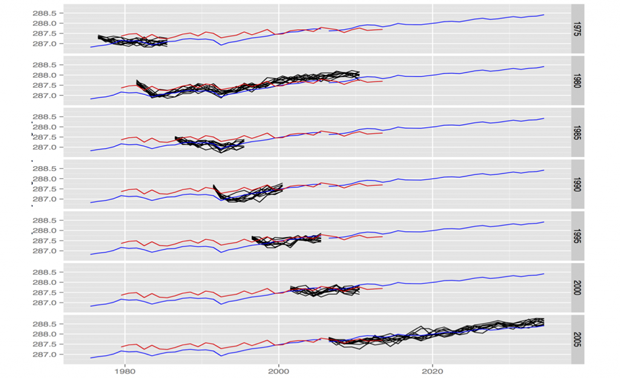Ana Maria Kupresanin (14-ERD-095)
Abstract
The current state of the art in providing robust global climate predictions for the 21st century is based on mining the Coupled Model Intercomparison Project database of multiple-model ensembles of global climate model simulations. The latest incarnation of the Coupled Model Intercomparison Project (Phase 5) includes a new set of simulations aimed at providing decadel climate simulations to explore the variation across models in predicting the climate one to three decades out. However, uncertainty in decadal climate simulations is mainly driven by structural uncertainty in global climate models, uncertainty in natural external forcing such as volcanic and solar activity, and natural intrinsic climate variability. We plan to provide improved probabilistic decadal regional-scale climate predictions that are suitable for general climate-change risk assessment and decision support. We will use our new set of simulations and develop advanced Bayesian multiple-model decadal prediction methods and assess the impact of forcing uncertainty on climate predictions.
Our three main objectives with this project include providing (1) decadel climate predictions that reflect the capability of individual global climate models to produce decadel simulations, (2) additional regional-scale information to resolve important small-scale processes using targeted shorter-term high-resolution simulations, and (3) climate impact quantities of interest scaled to regional and local areas using statistical methods as well as global-scale predictions in combination with targeted high-resolution simulations. We expect our project will yield statistical methods and algorithms to produce realistic probabilistic decadal regional climate predictions by leveraging the multiple-model ensembles database of climate simulations from the Coupled Model Intercomparison Project (Phase 5). The uncertainty in the simulation will reflect and account for the structural uncertainty across models, the natural variability in the climate, and uncertainty in natural forcing of the system. Through targeted short-term simulations, this work will provide deeper insight into the impact that uncertainty in past and near-future natural forcing will have on climate projections. We intend to deliver the capability to synthesize weather-related processes that are needed as inputs for other climate models, such as hydrology, that reflect large-scale, near-term decadel variation and trends in the global climate process.
Mission Relevance
Providing regional-scale climate predictions on a timescale of several decades that are suitable for general climate-change risk assessment is well aligned with the Laboratory's strategic focus area in energy and climate security to understand climate challenges and develop options for future adaption, including decadal climate projections at the regional scale. Mining data from climate simulations also aligns well with the core competency in high-performance computing, simulation, and data science.
FY15 Accomplishments and Results
In FY15 we (1) developed and implemented Python tools for biological computation to data collection, specifically to gather over 140 gigabytes of climate model output as well as observations for a specified climate variable, and aggregated the data to desired temporal scale and spatial regions; (2) tested and developed preliminary modeling structures defined for a decadal climate-prediction model—observations and single climate-model output were modeled jointly; (3) developed and completed an initial prototype of a statistical deconvolution model for accessing and analyzing the impact of forcing uncertainty for a specified climate variable; and (4) began the preliminary work for joint climate variable and forcing uncertainty modeling.
Publications and Presentations
- Beltran, F. M., B. D. Santer, and G. Johannesson, Quantifying the impact of volcanic aerosol forcing uncertainties on lower troposphere temperature. Joint Statistical Mtg., Seattle, WA, Aug. 8–13, 2015. LLNL-ABS-799361.
- Santer, B. D., et al., Climate impact of volcanic forcing uncertainty. (2015). LLNL-JRNL-677157.
- Santer, B. D., et al., “Volcanic effects on climate.” Nat. Clim. Change 6, 3 (2015). LLNL-JRNL-673787.






